- Author Curtis Blomfield [email protected].
- Public 2023-12-16 20:44.
- Last modified 2025-01-23 17:01.
The appearance on the pharmacological market of new antibiotics with a wide range of effects, such as fluoroquinolones, cephalosporins, has led to the fact that doctors have become extremely rare to prescribe aminoglycosides (drugs). The list of medicines included in this group is quite extensive, and includes such well-known drugs as Gentamicin, Amikacin, Streptomycin. Streptomycin, by the way, is considered historically the first aminoglycoside. It is also the second known antibiotic after penicillin. Aminoglycosides, or rather, aminoglycoside preparations, remain to this day the most in demand in intensive care and surgical departments.
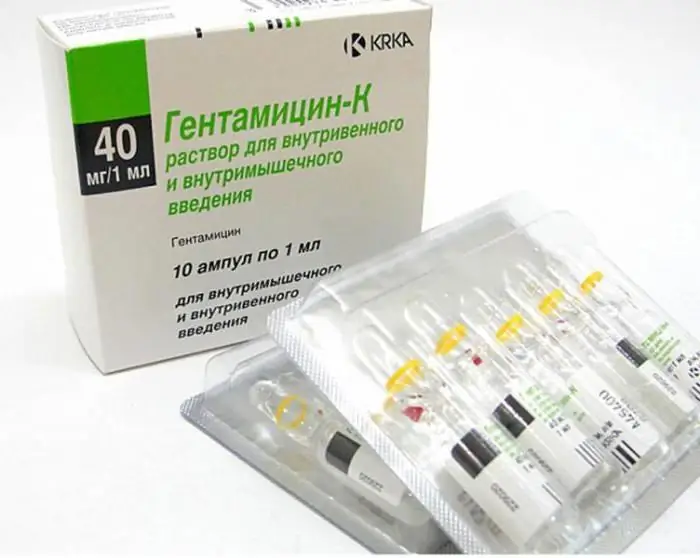
Brief description of the group
Aminoglycosides are drugs (list of drugs will be discussed below) that differ in semi-synthetic or natural origin. This group of antibiotics has a rapid and powerful bactericidal effect onorganism.
Medicines have a wide spectrum of action. Their antimicrobial activity is pronounced against gram-negative bacteria, but is significantly reduced in the fight against gram-positive microorganisms. And aminoglycosides are completely ineffective against anaerobes.
This group of drugs produces an excellent bactericidal effect due to the ability to irreversibly inhibit protein synthesis in sensitive microorganisms at the level of ribosomes. Medicines are active in relation to both multiplying and resting cells. The degree of activity of antibiotics depends entirely on their concentration in the patient's blood serum.
The group of aminoglycosides is currently used to a limited extent. This is due to the high toxicity of these drugs. The kidneys and hearing organs are most often affected by such drugs.
An important feature of these funds is the impossibility of their penetration into a living cell. Thus, aminoglycosides are completely powerless in the fight against intracellular bacteria.
Advantages and disadvantages
These antibiotics are widely used, as mentioned above, in surgical practice. And it is no coincidence. Doctors emphasize the many benefits that aminoglycosides have.
The effect of drugs on the body is distinguished by such positive aspects:
- high antibacterial activity;
- lack of painful reaction (when injected);
- rare occurrence of allergies;
- the ability to destroybreeding bacteria;
- enhanced therapeutic effect when combined with beta-lactam antibiotics;
- high activity in the fight against dangerous infections.
However, along with the advantages described above, this group of medicines also has disadvantages.
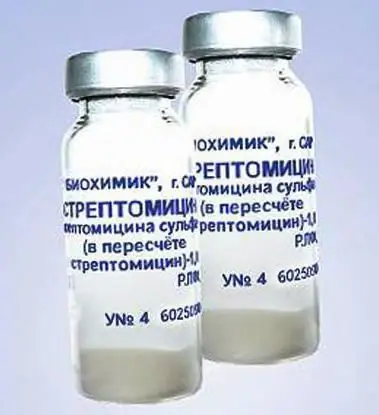
The cons of aminoglycosides are:
- low activity of drugs in the absence of oxygen or in an acidic environment;
- poor penetration of the main substance into body fluids (bile, cerebrospinal fluid, sputum);
- many side effects.
Classification of medicines
There are several classifications.
Thus, given the sequence of introduction of aminoglycosides into medical practice, the following generations are distinguished:
- The first drugs used to fight infectious diseases were Streptomycin, Monomycin, Neomycin, Kanamycin, Paromomycin.
- The second generation includes more modern aminoglycosides (drugs). Drug List: Gentamycin, Tobramycin, Sizomycin, Netilmicin.
- This group includes semi-synthetic drugs such as Amikacin, Isepamycin.
Aminoglycosides are classified somewhat differently according to the spectrum of action and the emergence of resistance.
Generations of drugs are as follows:
1. Group 1 includes such drugs: Streptomycin, Kanamycin, Monomycin, Neomycin. These medicines allow you to fight the causative agents of tuberculosis and someatypical bacteria. However, they are powerless against many gram-negative microorganisms and staphylococci.
2. The representative of the second generation of aminoglycosides is the drug "Gentamicin". It is distinguished by great antibacterial activity.
3. Better medicines. They have high antibacterial activity. Applied against Klebisiella, Enterobacter, Pseudomonas aeruginosa is the third generation of aminoglycosides (drugs). The list of medicines is as follows:
- "Sizomycin";
- Amikacin;
- "Tobramycin";
- Netilmicin.
4. The fourth group includes the drug "Isepamycin". It is distinguished by the additional ability to effectively fight Cytobacter, Aeromonas, Nocardia.
In medical practice, another classification has been developed. It is based on the use of drugs depending on the clinic of the disease, the nature of the infection, as well as the method of application.
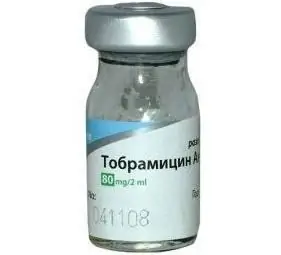
This classification of aminoglycosides is as follows:
- Medicines for systemic effects, administered parenterally (by injection). For the treatment of bacterial purulent infections occurring in severe forms, provoked by opportunistic anaerobic microorganisms, the following drugs are prescribed: Gentamicin, Amikacin, Netilmicin, Tobramycin, Sizomycin. Treatment of dangerous monoinfections, which are based on obligate pathogens, is effective when the drugs "Streptomycin", "Gentomycin" are included in the therapy. Great for mycobacteriosismedicines Amikacin, Streptomycin, Kanamycin.
- Drugs that are used exclusively by mouth for special indications. These are: Paromycin, Neomycin, Monomycin.
- Medicines for local use. They are used for the treatment of purulent bacterial infections in otorhinolaryngology and ophthalmology. For local action, preparations "Gentamicin", "Framycetin", "Neomycin", "Tobramycin" have been developed.
Indications for prescription
The use of aminoglycosides is appropriate for the destruction of a wide variety of aerobic gram-negative pathogens. Medicines can be used as monotherapy. They are often combined with beta-lactams.
Aminoglycosides prescribed for treatment:
- hospital infections of various localization;
- purulent postoperative complications;
- intra-abdominal infections;
- sepsis;
- infective endocarditis;
- pyelonephritis occurring in severe forms;
- infected burns;
- bacterial purulent meningitis;
- tuberculosis;
- dangerous infectious diseases (plague, brucellosis, tularemia);
- septic arthritis caused by Gram-negative bacteria;
- urinary tract infections;
- ophthalmic diseases: blepharitis, bacterial keratitis, conjunctivitis, keratoconjunctivitis, uveitis, dacryocystitis;
- otorhinolaryngological ailments: otitis externa, nasopharyngitis, rhinitis, sinusitis;
- protozoan infections.
Sideeffects
Unfortunately, during therapy with this category of drugs, the patient may experience a number of undesirable effects. The main disadvantage of medicines is high toxicity. That is why only a doctor should prescribe aminoglycosides to a patient.
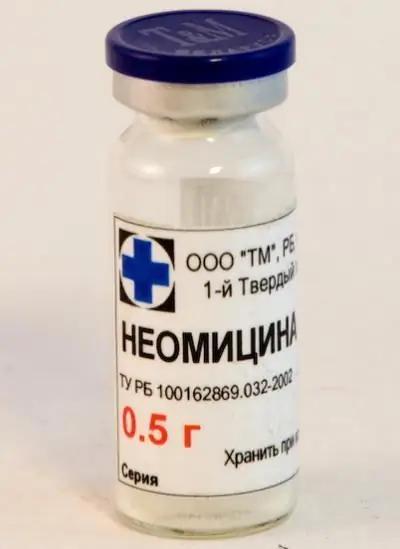
Side effects may occur:
- Ototoxicity. Patients complain of hearing loss, ringing, noise. Often they indicate stuffy ears. Most often, such reactions are observed in the elderly, in people who initially suffer from hearing impairment. Similar reactions develop in patients with long-term therapy or high doses.
- Nephrotoxicity. The patient develops a strong thirst, the amount of urine changes (it can both increase and decrease), the level of creatinine in the blood rises, and glomerular filtration decreases. Similar symptoms are characteristic of people suffering from impaired functioning of the kidneys.
- Neuromuscular blockade. Sometimes during therapy, breathing is depressed. In some cases, paralysis of the respiratory muscles is even observed. As a rule, such reactions are characteristic of patients with neurological diseases or impaired kidney function.
- Vestibular disorders. They are manifested by impaired coordination, dizziness. Very often, such side effects appear when the patient is prescribed the drug Streptomycin.
- Neurological disorders. Paresthesia, encephalopathy may appear. Sometimes therapy is accompanied by damage to the optic nerve.
Veryrarely aminoglycosides cause allergic manifestations such as skin rash.
Contraindications
The described medicines have some restrictions on their use. Most often, aminoglycosides (whose names were given above) are contraindicated in such pathologies or conditions:
- individual hypersensitivity;
- impaired excretory function of the kidneys;
- hearing disorders;
- development of severe neutropenic reactions;
- vestibular disorders;
- myasthenia gravis, botulism, parkinsonism;
- oppressed breathing, stupor.
In addition, they should not be used for treatment if the patient's history had a negative reaction to any drug from this group.
Let's take a look at the most popular aminoglycosides.
Amicacin
The drug has a pronounced bacteriostatic, bactericidal and anti-tuberculosis effect on the human body. It is highly active against many Gram-positive and Gram-negative bacteria. So testifies to the drug "Amikacin" instructions for use. The injections are effective in the treatment of staphylococci, streptococci, pneumococci, salmonella, Escherichia coli, mycobacterium tuberculosis.
The drug is not able to be absorbed through the gastrointestinal tract. Therefore, it is used only intravenously or intramuscularly. The highest concentration of the active substance is observed in the blood serum after 1 hour. The positive therapeutic effect persists for 10-12 hours. Due to this property, the injectionperformed twice a day.
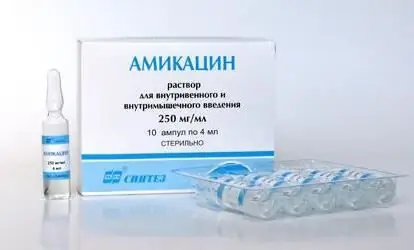
When does the instruction for use recommend using the drug "Amicacin"? Injections are indicated for the following ailments:
- pneumonia, bronchitis, lung abscesses;
- infectious diseases of the peritoneum (peritonitis, pancreatitis, cholecystitis);
- diseases of the urinary tract (cystitis, urethritis, pyelonephritis);
- skin pathologies (ulcerative lesions, burns, bedsores, infected wounds);
- osteomyelitis;
- meningitis, sepsis;
- TB infections.
Often this remedy is used for complications caused by surgery.
The use of the drug in pediatric practice is allowed. This fact confirms the instructions for use for the drug "Amikacin". For children from the first days of life, this medicine can be prescribed.
Dosages are determined solely by the doctor, depending on the patient's age and body weight.
The instruction gives the following recommendations:
- For 1 kg of the patient's weight (both adults and children) should be 5 mg of medication. With this scheme, a second injection is given after 8 hours.
- If 7.5 mg of medication is taken per 1 kg of body weight, then the interval between injections is 12 hours.
- Pay attention to how it recommends using the drug "Amikacin" for newborns instructions for use. For children who have just been born, the dosage is calculated as follows: per 1 kg - 7.5 mg. At the same time, the interval between injections is 18hours.
- Duration of therapy can be 7 days (with IV injection) or 7-10 days (with IM injections).
Netilmicin
This medicine is similar in its antimicrobial effect to Amikacin. At the same time, there are cases when "Netilmicin" was highly effective against those microorganisms in which the above medicine was powerless.
The drug has a significant advantage over other aminoglycosides. As the instructions for use indicate to the drug "Netilmicin", the drug has less nephro- and ototoxicity. This medicine is for parenteral use only.
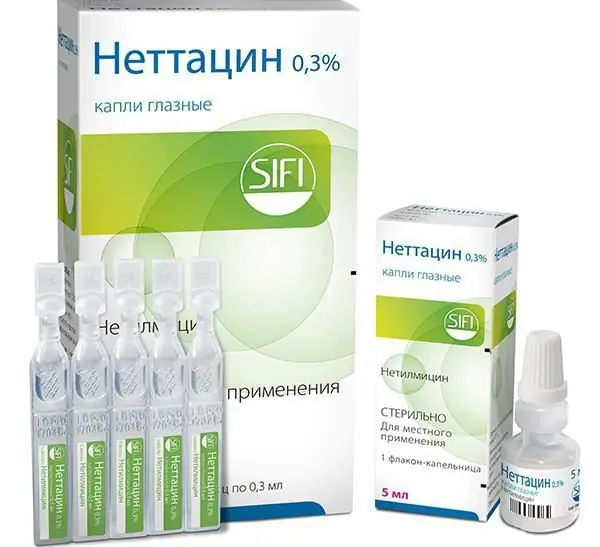
"Netilmicin" instructions for use recommends prescribing:
- for septicemia, bacteremia,
- for the treatment of suspected Gram-negative infection;
- for infections of the respiratory system, urogenital tract, skin, ligaments, osteomyelitis;
- newborn in case of serious staphylococcal infections (sepsis or pneumonia);
- for wound, preoperative and intraperitoneal infections;
- in case of risk of postoperative complications in surgical patients;
- for infectious diseases of the gastrointestinal tract.
The recommended dose is determined only by the doctor. It can range from 4 mg to 7.5 mg. Depending on the dosage, the condition of the patient and his age, 1-2 injections are recommended during the day.
Drug "Gentamicin"
Produced as ointment, injection and tablets. The drug has pronounced bactericidal properties. It provides a detrimental effect on many gram-negative bacteria, Proteus, Campylobacter, Escherichia, Staphylococcus, Salmonella, Klebsiella.
The drug "Gentamicin" (tablets or solution), getting into the body, destroys pathogens at the cellular level. Like any aminoglycoside, it provides a violation of protein synthesis of pathogens. As a result, such bacteria lose their ability to reproduce further and cannot spread throughout the body.
An antibiotic is prescribed for infectious diseases affecting various systems and organs:
- meningitis;
- peritoneal;
- prostat;
- gonorrhea;
- osteomyelitis;
- cystitis;
- pyelonephritis;
- endometritis;
- pleural empyema;
- bronchitis, pneumonia;
Gentamicin is quite in demand in medicine. It allows you to cure patients of serious infections of the respiratory and urinary tract. This remedy is recommended for infectious processes involving the peritoneum, bones, soft tissues or skin.
Aminoglycosides are not intended for self-treatment. Do not forget that only a qualified doctor can choose the necessary antibiotic. Therefore, do not self-medicate. Trust your he alth to professionals!






